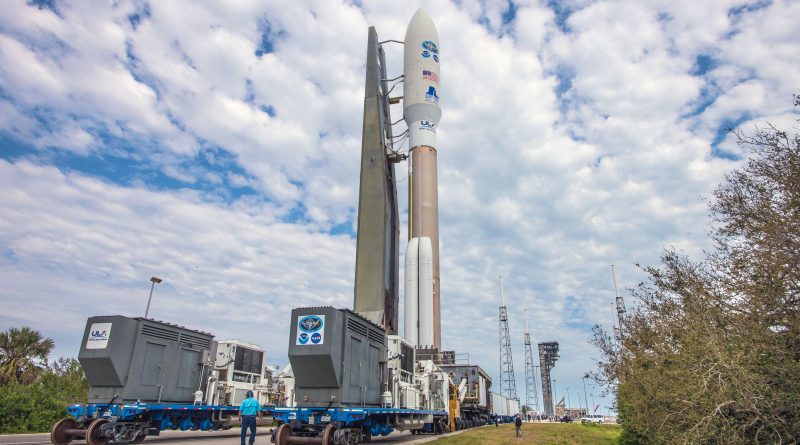Atlas V to Add Second Next-Generation Satellite to U.S. GOES Weather Constellation
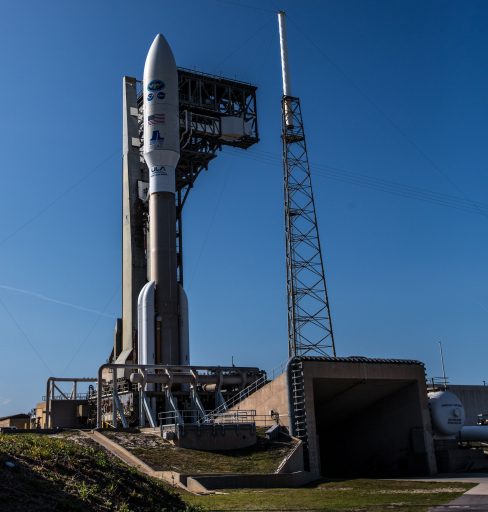
A United Launch Alliance Atlas V rocket rolled to its Cape Canaveral launch pad on Wednesday in preparation for liftoff Thursday afternoon with the second in the next-generation of U.S. Geostationary Meteorological Satellites to complete the operational constellation with two sharply-eyed weather assets watching over the Western Hemisphere from their high-altitude perch.
Thursday’s launch of NOAA’s GOES-S satellite follows the 2016 launch of GOES-R as the first in the fourth generation of GOES satellites, taking the four-decade satellite program into a new era of weather monitoring and forecasting. Atlas V is expected to leap off the ground at 22:02 UTC, 5:02 p.m. local time, rising into the skies over Florida’s Space Coast with the help of four Solid Rocket Boosters that give the vehicle the power needed to send the 5,200-Kilogram payload into a high-energy Geostationary Transfer Orbit over three and a half hours after liftoff.
To reach its orbital destination, Atlas V will travel halfway around the globe on Thursday, in the process firing its trusted Centaur upper stage three times to send the GOES-S satellite on two weeks of orbit-raising to set the stage for several months of checkouts before it can take an active role within the GOES constellation – assuming the position of GOES-West to watch over the Pacific Ocean and the continental United States.
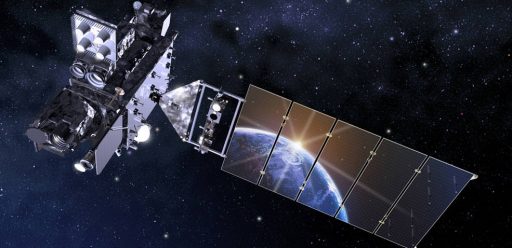
Launching in 2016, GOES-R ushered in a new age for weather forecasting as the fourth GOES generation is widely regarded as the most powerful meteorological satellites ever launched with benefits for operational meteorology and climate science – scanning the Earth five times faster than the previous generation of satellites, offering four times the resolution and expanding spectral coverage by a factor of three – and that is only for the satellite’s primary Earth-watching instrument.
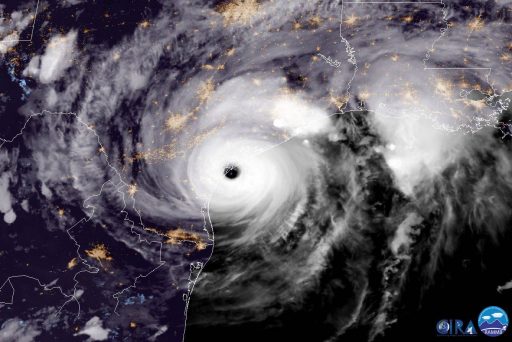
GOES-R already proved its worth before entering service in December 2017 when saving lives through accurate wind and rainfall predictions for Hurricane Harvey that caused major flooding in Texas in August & September and GOES-R was also on the case when Hurricane Irma trekked across the Atlantic, predicting its landfall location over the Florida Keys with over 24 hours of lead time. Naturally, there is great desire among the meteorological community to receive an equivalent asset in the GOES-West location, watching over developments in the Pacific at high observation cadence.
The Geostationary Operational Environmental Satellites (GOES) have been the backbone of weather forecasting in the United States for the last 44 years, keeping constant watch over weather systems from a high-altitude vantage point 36,000 Kilometers above the equator.
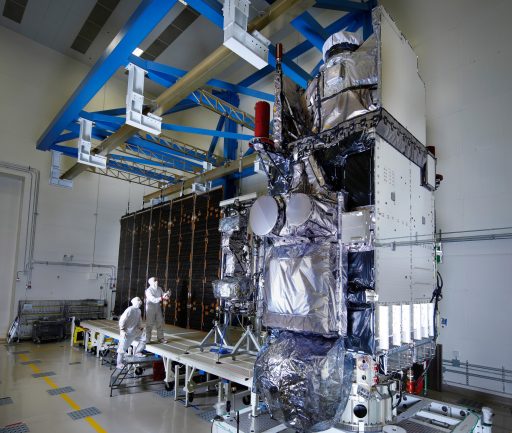
The first GOES satellite launched in 1974 and subsequent satellites gradually upgraded to color imaging, multi-spectral capabilities and added auxiliary instruments to measure space weather. The inauguration of the GOES-R-class satellites was likened to upgrading from a black-and-white television to high-definition color TV in terms of the improvement in image resolution and spectral coverage.
GOES-S is the second in a series of four functionally identical satellites and will begin active duties as GOES-West later this year while the next set of satellites launches in the 2020s to keep the system in operation until at least through the mid-2030, coming with a total price tag of $11 billion for all four satellites and their ground infrastructure tasked with delivering real-time data products, feeding into weather models and archiving data for later use by climate scientists.
Standing six meters tall and weighing in at 5,192 Kilograms at liftoff, GOES-S leverages Lockheed Martin’s flight-proven A2100 satellite platform and employs six state-of-the-art instruments to collect multi-band imagery of weather systems, take atmospheric sounding measurements, monitor lightning events with unprecedented accuracy & frequency, and watch over solar events and space weather with a high-energy instrument suite.
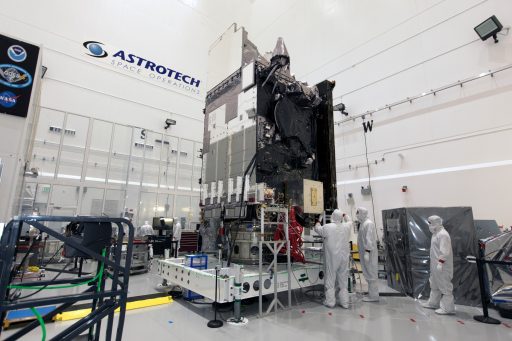
The satellite’s main advancement is found in its core instrument, the Advanced Baseline Imager ABI that generates 95% of the data coming from GOES in the form of imagery and sounding products across 16 spectral channels. ABI scans the entire visible disk of Earth every five minutes and focuses on events of interest every thirty seconds to monitor fast-moving weather systems like powerful thunderstorms or tropical storms at a resolution of up to 0.5 Kilometers. Heritage systems needed 26 minutes to collect a full-disk image and only covered five spectral channels, highlighting ABI’s role as a dual instrument for imaging and infrared sounding of the atmosphere.
Because ABI combines the capabilities of two instruments, GOES had a free slot that could be taken up by GLM – the Global Lightning Mapper, the first instrument capable of accurate day-and-night lightning detection to provide insight into the formation of storms and enhance warning reliability for tornado outbreaks and other severe weather events. GLM uses a unique approach capturing 500 frames each second and putting them through an advanced algorithm to pin-point all types of lightning before transmitting data back to the ground.
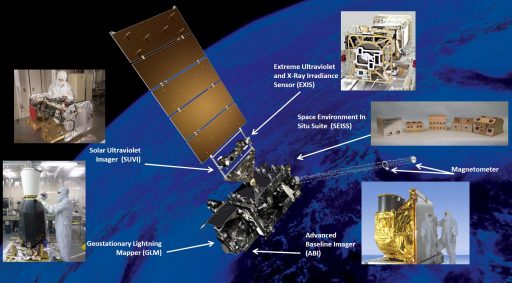
Vastly improved solar instruments riding on GOES deliver insight into ultraviolet and X-ray emissions from the sun to monitor coronal mass ejections & solar flares and better predict impacts on satellite communications, navigation and power grids. Two in-situ instruments measure the particle and electromagnetic environment in near-Earth space to provide the first measurements of an incoming space weather event and issue warnings for electrostatic and radiation hazards that can be harmful to satellites and astronauts.
GOES-R became GOES-16 on December 18, 2017 when it assumed active duty after over a year of instrument calibration and characterization. By that time, its identical twin GOES-S, was already at its Cape Canaveral Launch site after delivery on December 4th to begin final testing for launch and load up on maneuvering propellant for its 15-year mission in orbit. The launch target for GOES-S, March 1st, 2018, was able to stand for over a year without any delays on the satellite or launch vehicle side.
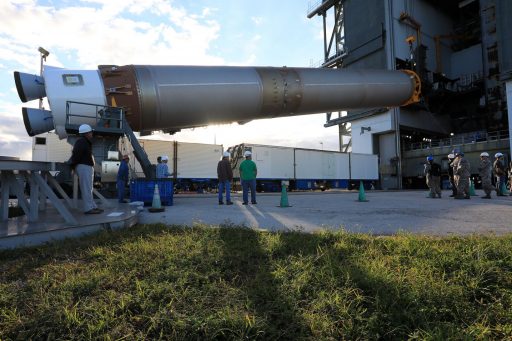
Because Atlas V had been on the Eastern Range for several months, its launch takes priority over SpaceX’s planned Falcon 9 launch with the Hispasat 30W-6 communications satellite. SpaceX was forced to delay the mission from last Sunday for additional checks of the Falcon 9 Fairing Pressurization System and had requested the range for early March 1st to get Falcon 9 off the ground around 17 hours before Atlas V opens its launch window.
The U.S. Air Force-operated Eastern Range is ultimately working towards a capability of supporting same-day launches through innovations like Autonomous Flight Safety Systems as currently flying on Falcon 9 and part of future vehicle designs that would lessen the amount of range reconfiguration work necessary in between launches. While it would have been theoretically possible for the range to support Falcon 9 just over a half a day before Atlas V, an additional concern arising for these two vehicles is their use of adjacent launch pads with only 2.5 Kilometers separating SpaceX’s Space Launch Complex 40 from ULA’s SLC-41 launch pad to the north.
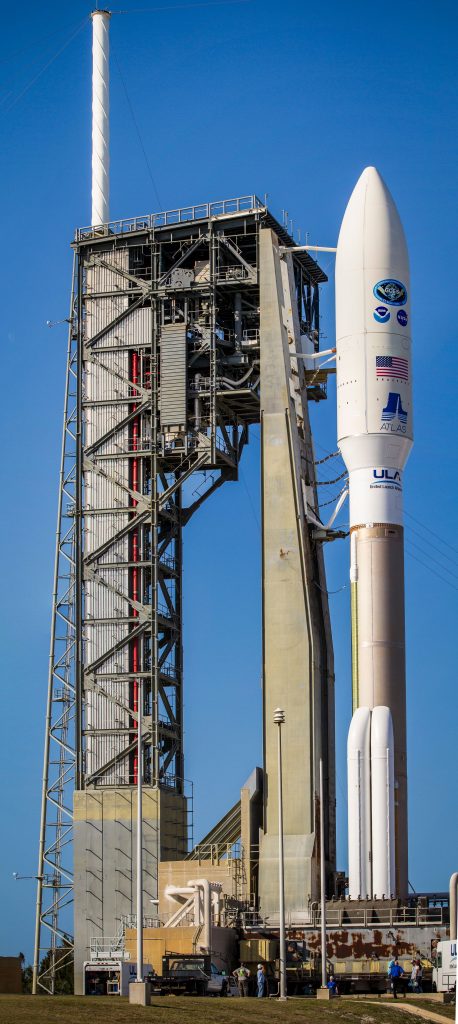
Both launch facilities use clean-pad concepts without retractable service gantries to provide protection to the rocket to shield it from plums and lifted debris from another rocket launching from the adjacent pad, let alone debris in case of a mishap close to the ground. In case of Atlas V, rollout to the pad is needed the day before launch to facilitate final checks and fuel loading on the first stage – leaving it exposed for one night.
With a potential dual-launch-day on the horizon initial discussions were held by the Eastern Range and all involved parties, yielding a decision to give priority to Atlas V which is booked for Thursday and a backup day on Friday and then shuffling Falcon 9 behind the Atlas.
A driver of the decision-making process were concerns by NASA of leaving the Atlas and a $500 million satellite out in the open without completing the proper risk assessment work prior to Falcon 9 taking flight.
SpaceX informed the media on Tuesday that the fairing checks had been completed and Falcon 9 remains in readiness for launch once a date can be established with the Eastern Range.
Meanwhile, ULA and NASA completed the Launch Readiness Review for GOES-S, clearing Atlas V to proceed into rollout operations. The 62-meter tall Atlas V emerged from its assembly facility at 10 a.m. local time on Wednesday for a half-hour trip over to the SLC-41 launch pad. Carefully centered on its pad, Atlas V was to be connected to commodity lines, receive some 94,600 liters of rocket-grade Kerosene and go through initial checks in preparation for countdown operations on Thursday.
Meteorologists have issued an 80% chance of favorable weather conditions in their L-1 forecast, calling for a slight threat of cumulus clouds and high ground winds as the result of a pressure gradient associated with a frontal boundary pushing into the Florida Panhandle. Conditions are expected to be best early on in the two-hour window. In the event of a 24-hour delay, the front will move further into Central Florida, bringing a slight shower threat and potential for violations of the cumulus cloud rule.
Countdown & Launch Sequence
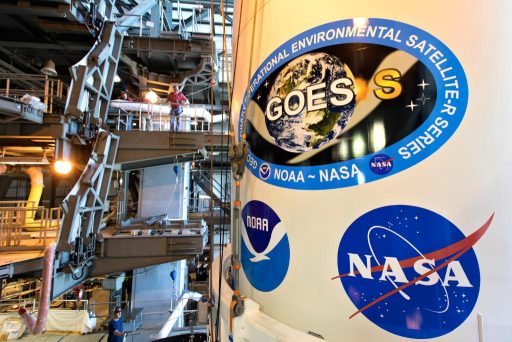
Ahead of the countdown, technicians will already be busy at the pad, completing final hands-on work and closing out the Vertical Integration Facility, pad facilities and the Atlas V launcher. The first step completed at T-6 Hours 20 Minutes is the activation of the Atlas V rocket for a multi-hour testing campaign.
The Atlas V 541 is beefed up with four Solid Rocket Boosters attached to the Common Core Booster & Centaur stack. It marks only the sixth launch of the 541 version that flew for the first time in 2011 with the Mars Science Laboratory Rover followed by three launches for the National Reconnaissance Office and the GOES-R mission.
>>Atlas V 541 Launch Vehicle Overview
Following the activation of the launcher, teams begin a series of checkouts of the electrical system of the rocket. Meanwhile, at the launch pad, technicians complete final hands-on work.
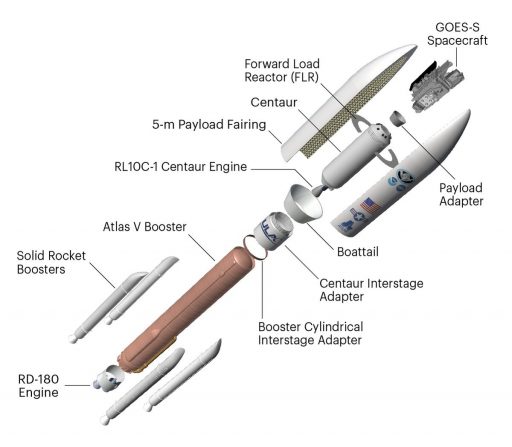
While that is in progress, the Launch Team puts the Atlas V through a series of communication checks on its S- and C-Band Systems and purge flows are set up in preparation for propellant loading. By L-3 hours, the launch pad is cleared by all personnel.
At T-2 Hours, the countdown enters a built-in hold during which teams perform the fueling pre-task briefing and the GO/No GO Poll for propellant loading. The complex procedure to load the two stages of the rocket with cryogenics begins as the count comes out of the hold with the chilldown of ground support equipment and transfer lines and tanks chilldown on the Liquid Oxygen side.
Liquid Oxygen starts flowing into the Centaur upper stage tanks shortly thereafter. Centaur LOX loading takes about 40 minutes as 15,700 liters of –183-degree Celsius oxidizer are filled into the upper stage. Once Centaur is into propellant loading, the large Liquid Oxygen tank of the Common Core Booster also starts fueling. LOX load on the CCB also moves through the three steps, slow-fill, fast-fill and topping.
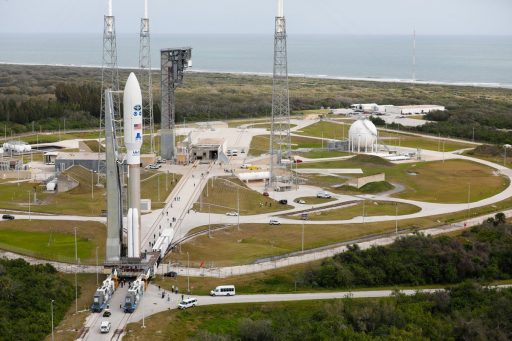
The final tank to be loaded during the countdown is the Liquid Hydrogen Tank of the upper stage that also goes through the usual steps. Centaur is loaded with a total of 48,100 liters of -253-degree Celsius LH2 fuel. Centaur can look back at over 200 previous missions under its belt – most of which coupled with an Atlas – a duo that has been operating for several decades.
When clocks reach T-4 Minutes, the countdown enters its final built-in hold for final polling of the launch team prior to pressing into Terminal Count. As clocks start ticking down from T-4 Minutes, final vehicle configurations such as ordnance arming, flight termination system arming, propellant tank pressurization, transfer to internal power, and flight control system reconfigurations will be made as part of the Automated Sequence to place the vehicle in its launch configuration.
At T-2.7 seconds, the massive two-chamber RD-180 main engine of the Common Core Booster ignites and soars up to its full liftoff thrust of 390,250 Kilogram-force.
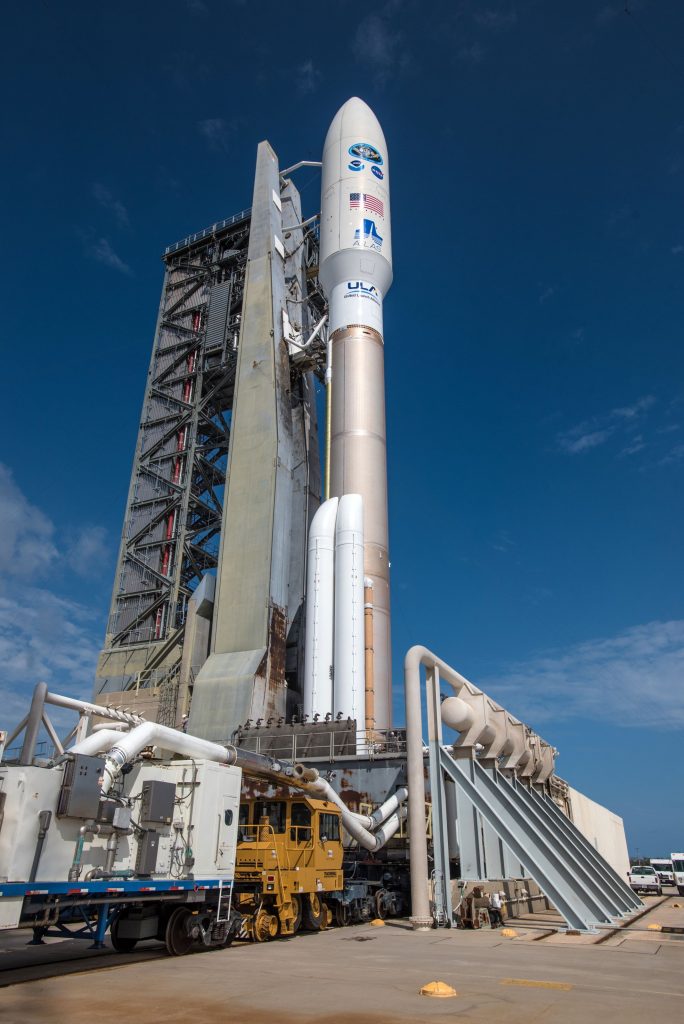
As the four boosters ignite, Atlas V will jump off the pad with a liftoff thrust of 1,080-metric-ton-force, creating an initial thrust to weight ratio of 2.0. Less than six seconds after liftoff, Atlas V will start its roll and pitch program to align itself with its precise ascent path, heading east-south-east on the standard route to Geostationary Transfer Orbit from Cape Canaveral. Atlas V will pass the speed of sound 35 seconds after blastoff and encounter Maximum Dynamic Pressure just after passing 47 seconds into the flight, briefly throttling back on its Russian-built main engine.
Burning out after 94 seconds, the four SRBs will have completed their job of providing that extra push needed to boost GOES into orbit. The vehicle will hold onto the SRMs for about 16 more seconds before separating them in a staggered fashion – first jettisoning SRMs 1 and 2 followed 1.5 seconds later by the remaining two boosters.
Powered by the RD-180 engine alone, Atlas V will continue its flight, burning 1,150 Kilograms of propellant each second to generate a thrust of 422 metric tons when flying through the tenuous upper atmosphere. Climbing out, Atlas V will separate its protective payload fairing three minutes and 30 seconds after launch along with the Forward Load Reaction to shed no-longer-needed weight on its way toward orbit.
Approaching the end of the first stage burn, the RD-180 engine will be throttled back to maintain a maximum acceleration of 4.6 Gs. Shutdown of the Common Core Booster occurs at T+4 minutes and 22 seconds followed six seconds later by stage separation that is accomplished by firing pyrotechnics and igniting eight retrorockets on the CCB to safely take it away from the Centaur Upper Stage.
Centaur will purge its Reaction Control System and fire up its RL-10C engine at T+4 minutes and 38 seconds on the mission’s first of three main engine burns tasked with pushing the stack into a slightly elliptical Parking Orbit with a thrust of 10,40 Kilogram-force.The burn is expected to last seven minutes and 38 seconds, lifting the stack into an orbit of around 165 x 540 Kilometers.
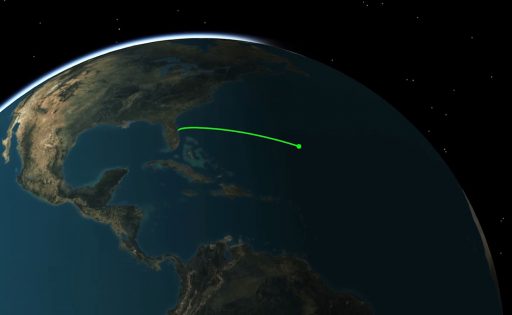
The GOES satellites do not take the standard route to Geostationary Transfer Orbit which would require two upper stage burns – the first to a Parking Orbit and the second over the equator to raise the apogee. Instead, GOES uses a three-burn mission to achieve an orbit closer to GEO in terms of the change in velocity needed by the spacecraft to boost itself to its operational orbit – increasing the mission’s overall propellant margin that could yield another four additional years of spacecraft operation if permitted by systems health.
The second burn is planned to begin 22 minutes and 38 seconds into the flight and last for 5 minutes and 31 seconds to boost the apogee of the orbit to around 32,000 Kilometers, located over the equator on the opposite side of the planet. Next is a long coast phase of exactly three hours to allow the stack to gain altitude in order to perform the burn at the apogee location of the desired GTO transfer orbit in so lift the high point to match GEO while also raising the perigee altitude and firing the RL-10C slightly out of plane for a reduction of orbital inclination – all geared toward delivering GOES-S closer to its operational orbit.
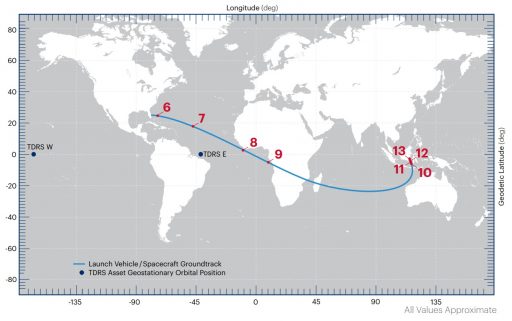
The long coast phase will see the stack fly over South-Central Africa, heading out over Madagascar for a lengthy pass over the Indian Ocean ahead of the critical re-start of the Java Sea.
The third burn will be just 94.4 seconds in duration beginning three hours, 28 minutes and eight seconds into the flight, targeting an insertion orbit of 8,215 by 35,287 Kilometers at an inclination of 9.52 degrees.
Separation of the GOES-S spacecraft is expected three hours and 32 minutes after liftoff to be sent on its way to complete eight days of orbit-raising and four days of fine-tuning to arrive in its desired Geostationary Orbit. Partial Solar Array deployment is planned six minutes after separation and two-way command and telemetry operations should be established by T+3 hours and 52 minutes.

